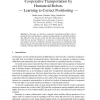Free Online Productivity Tools
i2Speak
i2Symbol
i2OCR
iTex2Img
iWeb2Print
iWeb2Shot
i2Type
iPdf2Split
iPdf2Merge
i2Bopomofo
i2Arabic
i2Style
i2Image
i2PDF
iLatex2Rtf
Sci2ools
HIS
2003
2003
Cooperative Transportation by Humanoid Robots: Learning to Correct Positioning
In this paper, we describe a cooperative transportation problem with two humanoid robots and introduce a machine learning approach to solving the problem. The difficulty of the task lies on the fact that each position shifts with the other’s while they are moving. Therefore, it is necessary to correct the position in a realtime manner. However, it is difficult to generate such an action in consideration of the physical formula. We empirically show how successful the humanoid robot HOAP-1’s cooperate with each other for the sake of the transportation as a result of Q-learning.
Cooperative Transportation Problem | HIS 2003 | HIS 2007 | Humanoid Robot | Machine Learning Approach |
| Added | 31 Oct 2010 |
| Updated | 31 Oct 2010 |
| Type | Conference |
| Year | 2003 |
| Where | HIS |
| Authors | Yutaka Inoue, Takahiro Tohge, Hitoshi Iba |
Comments (0)

